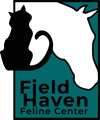The Highway 70 Dozen

Without all the facts, it’s not easy to guess a person’s thought process…most would like to give that same person the benefit of the doubt, to not assume negative intent. That being said, when it comes to a discovery so inhumane, so unthinkable…so brutally cruel – it feels like anything but forgivable and anger seems to be the only applicable emotion. You can only bear down, focus on the task at hand, and channel your energy into righting the wrong – especially when the wronged are innocent and undeserving of such an atrocity.
Placed (I won’t say “shoved”, I wasn’t there), in a crate was a multi-generation family of cats, some in various stages of maternity – 12 to be exact. As it turns out, it was 12 and counting: five pregnant females, a nursing mom with five kittens, and one male.
This crate was not set on the side of the road – it was dropped, tossed, or heaved as evident by the damage it sustained. Thankfully, they were found before this act resulted in tragedy. Upon opening the crate, the cat hero was greeted with 24 confused and scared eyes. CAT CARE specialist Robin Caples referred the call for help to Audra Murphy who then reached out to me, “WE NEED FOSTERS!”
Initially called the Hwy 70 Dozen, our new wards needed help and fast. With more entering the world as the rescued settled in, unforeseen issues came to light: mama Peony rejected her offspring so (pregnant) grandma Eloise took on the task…cancelling the plans to spay her. To interfere with Grandma’s milk-producing hormones when they were needed most would be a catastrophe. Oh…by the way, I forgot to mention Eloise is only 15 months old and this is her third time around. Not only are all the daughters from the first litter pregnant, they are not weaned from Eloise. As if this family tree’s branches couldn’t get any more tangled, it is quite possible the sons and/or brothers are responsible. This is common as well as frightening – a severe congenital jaw deformity caused by the inbreeding is evident in Eloise and at least one grandchild.
Circling back to the “why” of this story:
- Were the owners overwhelmed and unable to care for them properly?
- Did the cats belong to someone who passed away and the relatives didn’t know what to do with them?
- Were they a nuisance on someone’s property?
- Did this person feel it was safer to leave them in a container rather than just releasing them to fend for themselves?
- Some people are uninformed, at a loss, or just plain ignorant.
Any one of these scenarios is possible. For some it is second nature, for others a challenge to think beyond the (litter) box about what to do if presented with a like situation. Having been in the cat saving business for 18 years, I have pretty much seen it all and am not desensitized or immune from the pain. Every case slams into the heart…but lives depend on a level head so we push up our sleeves and get to work. The how or why no longer matters – it’s the what and when we have to focus on.
Could any of this be prevented? Certainly. Stories like this is precisely why you hear me, our staff, and our volunteers push for spaying or neutering cats and kittens. The cold hard truth is a simple procedure on ONE cat can save 1000’s of lives. One litter can multiply out of control in a heartbeat.
Unfortunately, this is not an isolated event. Although the play may have a different title, the plot is the same: thanks to unneutered males, unspayed female cats are reproducing at a rate too fast to keep up with, overwhelming the resources available to help them. With each new face or wanton female we bring in, it puts added strain on impacted shelter space, medical supplies, and general cat care. We are faced with gut-wrenching, heart-breaking decisions to keep or abort litters EVERY SINGLE DAY. Even though every consideration is weighed before the final outcome, we are judged by the actions we take – we are monsters no matter which course we choose. Times like these we must wear sound-cancelling headphones and Teflon T-shirts so we can proceed with the task at hand as efficiently, humanely, and effectively as we can with the resources available.
We are fortunate to live and work in Placer County with its great resources. It’s been a long road, travelling though the hell of no or low funds. Determination, hard work, and partnering up with other rescues and shelters made a difference in our local and neighboring communities. In 2018, backed with Placer County Animal Services and other Placer animal organizations, we were able assist Yuba County Animal Services, offering education, vaccines, microchips, and spay/neuter clinics. Prior to this, there were no low-cost county programs – nowhere for people to turn to for help. Sadly, these programs were discontinued before the year ended. However, shortly after they ended, the Marysville Police Department picked up the ball by approaching FieldHaven with a city-wide TNR program which has since expanded to other services for cats and dogs.
Perhaps the party responsible for the Hwy 70 is a Marysville resident but not aware of the help available at their fingertips. Won’t you help us spread the word and prevent unwanted kittens, untimely deaths, and overcrowded shelters?
